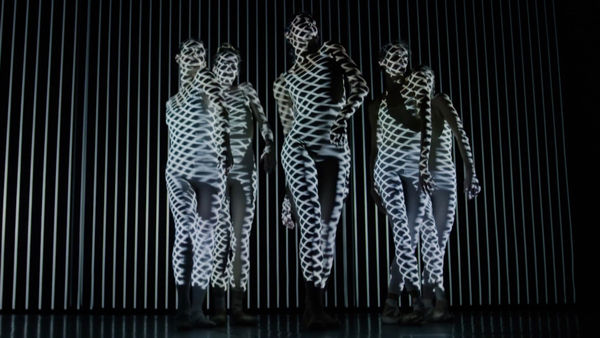First time visiting 10 Things?
Rather than a "review," each post features a collection of observations, intended primarily for people who've already seen the play. Check out the introduction post for more context.
Frame by Frame by Robert Lepage and Guillaume Côté
a collaboration between The National Ballet of Canada, Ex Machina and The National Film Board of Canada

Photo by Karolina Kuras
Despite attending 50+ live performances a year, I have only ever purchased tickets to two productions at the Four Seasons Centre for the Performing Arts: the Canadian Opera Company’s 2009 premiere of The Nightingale and Other Short Fables and Frame by Frame, the 2018 collaboration between the National Ballet of Canada, Ex Machina, and The National Film Board of Canada. With that idea in mind, I offer two notes: 1) My commentary of live performance is grounded in theatre, rather than dance, and 2) How segmented are Toronto’s arts audiences? What might a Venn diagram look like for patrons of theatre, musical theatre, ballet, contemporary dance, and opera? (Of course, I appreciate there aren’t rigid boundaries between genres and forms: some of my favourite audience experiences involved interdisciplinary pieces like DV8’s To Be Straight With You.)
With soaring glass walls and a gravity-defying staircase, the Four Seasons Centre for the Performing Arts is an architectural marvel. How many Torontonians ever step inside? Yes, there are free concerts held in the lobby, but I expect they don’t attract a representative cross-section of the city. Opening the space as a daytime café would signal its public accessibility — an essential element of all publicly-funded arts organizations and venues. (Although the theatre café/bar concept isn’t that common in Toronto, there are great spaces like the Theatre Centre…as well as Montreal, Europe, etc…)

Photo by Karolina Kuras
As with most productions touched by Lepage’s visual imagination, Frame by Frame features unforgettable moments that evoke a complete sense of awe. Wow. Just wow.
Whenever “traditionalists” — especially subscribers of the “original practices” doctrine — scoff at the ubiquitous use of digital technologies in contemporary performance, I’m reminded of Lepage’s message for World Theatre Day 2008:
One night, at the dawn of time, a group of men were gathered together in a quarry to warm themselves around a fire and tell stories. All of a sudden, one of them had the idea to stand up and use his shadow to illustrate his tale. Using the light from the flames he made characters appear, larger than life, on the walls of the quarry. Amazed, the others recognized in turn the strong and the weak, the oppressor and the oppressed, the god and the mortal.
Nowadays, the light of projectors has replaced the original bonfire, and stage machinery, the walls of the quarry. And with all due deference to certain purists, this fable reminds us that technology is at the very beginnings of theatre and that it should not be perceived as a threat but as a uniting element.
(Lepage elegantly continues this idea in the full text of the World Theatre Day 2008 message).
Further to the previous point, Frame by Frame sparkles brightest when dynamic choreography meshes with the innovative projections: frenetic movements amidst laser grids, as well as a pas de deux that superimposes the graceful lines of Heather Ogden and Harrison James onto the celluloid traces of McLaren’s iconic film.

Photo by Karolina Kuras
Frame by Frame is described as a “ballet based on the life and work of Canadian filmmaker Norman McLaren.” So, who is Norman McLaren? More precisely, I wonder about audience members: how much information do they know about McLaren’s film legacy and/or his personal life? The National Ballet provides extensive material in the program notes and their website; moreover, the National Film Board website features free access to his works. But how many patrons actually read programs or consult websites? I realize this is a universal question about biographical or historical works, and I don’t know it could be settled without some form of audience experiment (anyone know of any research on this topic?). In any case, I believe Frame by Frame manages to engage both the McLaren fan and the total neophyte; the show’s segments not only reference McLaren’s irrepressible curiosity, but can also stand alone as self-contained expressions of creativity.
Many biographical performances trace the subject’s history in chronological order; in Frame by Frame, projected slides occasionally appear to indicate the year or location, though a cohesive sense of time or space never really develops. In the big picture, though, Frame by Frame focuses on feelings rather than facts; the lack of a linear narrative untethers the show from the burdens of historical accuracy.

Photo by Karolina Kuras
Frame by Frame isn’t Lepage’s first exploration of artistic genius. Needles and Opium, for instance, reflects on the art and life of writer Jean Cocteau, using a kaleidoscopic mix of text, music, and projection. An even more specific similarity: both shows feature Wesley Robertson portraying a music legend (Oscar Peterson in Frame by Frame and Miles Davis in Needles and Opium).
Even with striking technical effects, Frame by Frame still emphasizes the limitless ingenuity of humans. For instance, Jack Bertinshaw (as Norman McLaren), moves with incredible electricity around (and on) an animator’s table, but the only “trick” is his own athletic prowess and artistic precision. (That scene does include an effect with a lamp, but that simple piece of whimsy simply highlights, rather than outshines, Bertinshaw’s performance).
Say what you will about using standing ovations as a barometer of audience approval, but following the performance that I attended, the crowd leapt to its feet.
-Nick Hanson
(Post-note: scholar Holger Syme offers a comprehensive rebuke for original practices in Shakespeare).
Comments